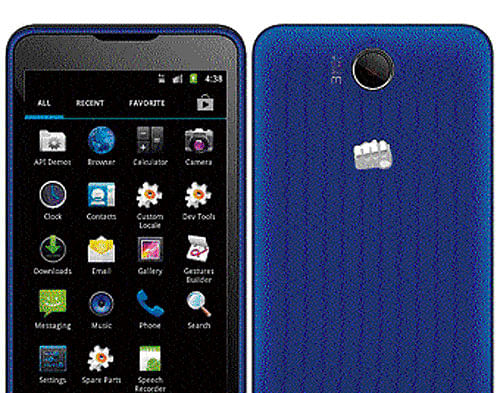
Samsung has been dethroned as the nation's largest smartphone vendor by homegrown handset maker Micromax, research firm Canalys said, but the Korean giant disputed this saying it still remains at the top.
Micromax has captured 22 per cent share in the India smartphone market in terms of shipment in the October-December 2014 quarter. Samsung was pushed to the number two slot with 20 per cent share, as per the Canalys report.
However, Samsung refuted the Canalys report saying it had 34.3 per cent market share in the Indian smartphone market as per GfK data, which is based on actual sales numbers, putting it ahead of the domestic rival.
Snubbing Canalys for "inaccuracy" in data, Samsung said that market research firm GfK gives actual sales figures, which is why it is preferred by the industry.
"We disagree with Canalys. We are not sure of the accuracy of the numbers (of Canalys). One is about shipments (Canalys) and the other reflects consumer sales (GfK). There is a reason that the industry syndicates and prefers GfK data," Samsung India VP Marketing (Mobile business) Asim Warsi told PTI.
GfK numbers are more scientific and reflect retail sales. Therefore, they are closest to consumers and show Samsung's leadership in the smartphone segment, he added.
Canalys said that in the October-December quarter, the Gurgaon-headquartered Micromax controlled 22 per cent market share in smartphones shipments in India -- one of the world's largest market for handsets -- beating Samsung which had 20 per cent market share.
"Micromax has remarkably ousted Samsung to become the first domestic vendor to take the top spot in the Indian smartphone market, the third largest in the world," Canalys said.
Micromax's flagship line of products has very effectively targeted the USD 150-200 (Rs 9,000-12,000) segment with products like Canvas Nitro and Canvas Hue, it added.
During the last quarter of 2014 in India, 23 per cent of the shipments were of devices priced under USD 100 (Rs 6,000), while 41 per cent were of devices in the USD 100-200 bracket (Rs 6,000-12,000), Canalys said.
According to Samsung, GfK data states that its volume market share during the quarter was 34.3 per cent and the value market share was 35.8 per cent.
"Our volume market share in the smartphone market in the year was 35.7 per cent, which is more than double than that of the next player, while our value share was 40.2 per cent, which is more than four times the next player. The GfK data is based on actual retail sales in 50,000-plus population cities," Warsi said.
Over the last few quarters, Samsung has gradually lost its market share in India to domestic players like Micromax, Lava, Karbonn as well as global rivals like Motorola and Xiaomi.
Globally too, Samsung has been facing tough competition from Apple and Chinese tech major Xiaomi.
Canalys said top four players during the October-December quarter in India by units shipped were Micromax, Samsung, Karbonn and Lava.
Overall, the Indian market experienced very strong annual growth of 90 per cent, with 21.6 million units shipped in the fourth quarter, it added.
Addressing these important segments (Rs 9,000-12,000) has helped it (Micromax) take 22 per cent share of the total smartphone market in India, ahead of Samsung at 20 per cent, Canalys said.
"Canalys believes catering to local market preferences will become increasingly important. Micromax has been quicker than its competitors to improve the appeal of devices, for example, by including a wide variety of local languages on its Unite phones," Canalys Analyst Rushabh Doshi said.
Lava, another domestic vendor, has launched devices that cater to the preference for greater battery life – in this case a couple of days, he added.
"But vital to success is selling these handsets at low price points to appeal to the bulging mid-level income market in India," Doshi said.
Samsung's market share globally share in the smartphone market has also witnessed a decline in the past couple of years.
In 2014, Samsung had 24.5 per cent share of the global smartphone market, 31.3 per cent in 2013 and 30.3 per cent in 2012, according to research firm IDC.
As per IDC, Apple managed to close the gap with rival Samsung after nearly 3 years at number two position in the global smartphone market as iPhone sales increased in Brazil, Russia, India and China (BRIC) as well as the US in Q4 2014.